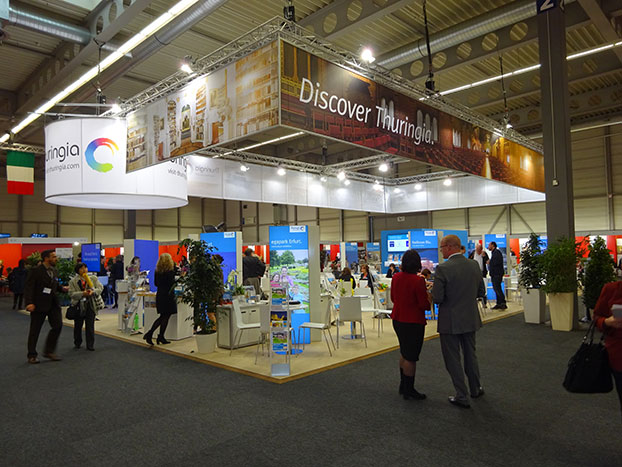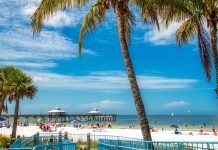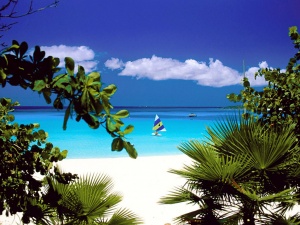May 12, 2015By: John Stone
 |
| Petra Hedorfer, CEO of the German National Tourist Board, welcomes delegates to cathedral concert. |
The German National Tourist Board (GNTB) convened its 41st Germany Travel Mart during the final weekend of April for the first time in the state of Thuringia, one of the five eastern states of the former German Democratic Republic. The meeting destination proved to have legitimate reasons for being promoted by the hosts as the new “heart of Germany.”
The primary site of the four-day meeting was Thuringia’s well-preserved capital city of Erfurt, with its historic structures dating from the 11th century. A pair of spectacular evening events were hosted by Erfurt’s neighboring cities of Weimar, the 1918 birthplace of Germany’s first post-monarch republic, and Eisenach, where 900-year-old Wartburg Castle commands a towering position as the best-preserved medieval castle in central Europe. Eisenach is the city where composer Johann Sebastian Bach was born, and Wartburg the castle where Martin Luther in 1521 started his translation of the New Testament from Greek to German, an achievement considered by historians a linguistic as well as religious milestone.
“Without this event the modern German language would not exist,” said Barbel Gronegres, managing director of Thuringia Tourism, to the Germany Travel Mart press conference.
Germany is now preparing to celebrate “Luther in Germany” as its tourism theme in 2017 to mark the 500th anniversary of Martin Luther’s posting of his 95 protests against Catholicism in 1517, the launch of the Protestant Reformation. Germany has years of tourism plans, however, for this central state of Thuringia beyond celebrating native sons Bach and Luther. As described by Petra Hedorfer, CEO of the GNTB in her opening press presentation, the marketing theme brand for all of Germany in 2016 is “Holidays in the Heart of Culture,” a brand that should serve Thuringia well beyond next year.
Gronegres described the unique qualities of Thuringia that allow visitors to have a variety of experiences in a short time. “In no other region of Germany is there such a close connection between culture and natural landscapes,” said the Thuringian Tourism Managing Director. “It is possible here to spend the morning in a museum, spend the afternoon in the forest, and spend the evening attending a classical music concert.”
 |
Location, Location, Location
An example of Thuringia’s cultural and natural interplay was on display during a welcome concert of highlight arias from the Richard Wagner opera “Tannhauser.” It was performed for German Travel Market delegates in the great hall of Weimar’s 11th-century Wartburg Castle, the same location where the story of the song contest within Wagner’s opera takes place. The concert guests were able to take in spectacular panoramic views of the rolling green hillsides of the Thuringian forests, a landscape crisscrossed by some of Germany’s most popular hiking trails and visible in all directions from the castle windows during breaks in the performance. The castle was declared a UNESCO World Heritage site in 2009.
Thuringia’s central geographic location in Germany, as inviting as its history, should command the attention of travel sellers drawing itineraries for clients considering a trip to central Europe. The state is a convenient midway stop – sprinkled with half-timbered, medieval towns steeped in history and surrounded by green parks – within a triangle of the larger famous cities on the eastern side of Germany. The eastern cities have grown in the tourism aspirations of Americans since Germany’s 1990 reunification, whose 25th anniversary will be celebrated this October.
A look at a Google map of the country will find the word “Germany” written directly over Thuringia, extending from the upper-right side of Frankfurt to the lower-left side of Leipzig. Within a right triangle drawn by locating Frankfurt at the lower left corner, Berlin at the upper right corner, Dresden midway down the right side, and Prague, the capital of Germany’s neighboring Czech Republic, at the lower right corner, Thuringia sits in the dead center. The capital city of Erfurt is only 160 miles from Frankfurt, 188 miles from Berlin, 135 miles from Dresden, and 223 miles from Prague.
Germany’s national railway company Deutsche Bahn, a co-sponsor of the German Travel Mart, discussed new, upcoming ICE speed train routes that will shorten travel times between the eastern cities and further heighten Thuringia’s location advantage. Robert Drose, a marketing executive in international sales for Deutsche Bahn, said the end of December 2015 will see a new speed train running from Frankfurt to Dresden in four hours 15 minutes, or 65 minutes faster than the current route. The Frankfurt to Leipzig part of the journey will be two hours 55 minutes, a saving of 35 minutes from the current time, and the Leipzig to Dresden part of the journey will only be one and ½ hours. A speedier north-south rail connection opens in 2018, according to Drose, when an Erfurt to Nuremburg speed rail will “close the last gap” between Munich and Berlin. This will allow rail travelers to go between Munich and Berlin in three hours 15 minutes.
In order to maximize its future success on the new speed routes, however, Deutsche Bahn will need to negotiate labor peace with its train operators union. There have been several strikes this year over a wage dispute and a desire by the union to expand by allowing service workers to join, a move opposed by the company. Bjorn Bender, Deutsche Bahn’s head of area management for Southern Europe, told the German Travel Mart press audience that the company is seeking a long-term settlement. “We take a huge interest in getting this fight off the table,” said Bender. “We really would like to come to a comprehensive agreement.”
 |
| The Thuringia exhibit booth at the GTM Trade Show in Erfurt, Germany. |
Germany’s Tourism Numbers
Germany has shown steady, five-year increases in inbound tourist arrivals, with 2014 proving to be another record year. According to figures released by the GNTB for the German Travel Mart, Germany received a record 75.6 million overnight stays last year. Hedorfer said visitor arrivals to Germany went up 4.6 percent in 2014, and have accelerated to 6 percent growth in the first two months of 2015, fueling strong hopes for another inbound Germany tourism record for the year now in progress.
While Europeans accounted for 75 percent of the 2014 guests, the U.S. continued to be the largest overseas market for Germany with a record 5.2 million overnight stays during the year, the first in which U.S. visitors accounted for more than 5 million overnights in Germany. The results from the U.S. market reflected an increase of 245,746 U.S. guest arrivals, a 5 percent year-over-year increase. The U.S. is the sixth largest international growth market for Germany, behind Switzerland, the Arab Gulf States, China, the UK and Poland.
The Germany Travel Mart “B2B Workshop,” designed as a pre-appointment format tradeshow, attracted 600 travel buyers and journalists from 45 countries visiting 340 suppliers exhibiting from across Germany. Trading floor activity was brisk with some popular destination and supplier representatives fully booked for the 20 minute sessions that, with the exception of 90-minute lunch breaks, extended over two full days.
Two poignant moments resonated with guests near the beginning and end of the official opening German Travel Mart concert hosted by the Thuringia Tourist Board in Erfurt’s majestic Cathedral of St. Mary, packed with delegates for the event. The first involved Wofgang Tiefensee, the former Federal Minister of Transport, Building and Urban Development, who now serves as Thuringia’s Minister for Economic Affairs, Science and Digital Society. Tiefensee delivered an engaging performance on the cello of the famous Canon by Johann Pachelbel, who was once a music teacher in Thuringia.
“I am grateful to the German Tourist Board for making all this possible,” said Tiefensee following a rousing audience response to his performance. “Please, when you go back home tell everyone about Thuringia.”
The last performance of the concert was a candlelight processional entrance to the cathedral stage by the chamber choir and orchestra of the Franz Liszt University of Music in Weimar, followed by the combined groups’ rousing performance of Beethoven’s “Ode to Joy” from his 9th Symphony, a work forever associated with the fall of the Berlin Wall in 1989. The impact of this musical transformation in short minutes from solemnity to jubilation had a strong impact on the assembled delegates. It was a stirring musical reminder in a few short minutes of why, 26 years after German reunification, the German Travel Mart had finally found its way to Thuringia.
 |
| Erfurt’s City Hall in the Thuringian capital’s Rathaus square. |
U.S. Travel Buyers at GTM
The GNTB hosted 30 U.S. travel buyers in Erfurt at the 2015 German Travel Mart, ranging from representatives of general interest tour operators including the Globus Family of Brands, Tauck, Avanti Destinations and Europe Express, to theme tour companies such as Luther Tours, Music Celebrations International and Reformation Tours LLC. Sandra Weinacht, the CEO of Incantato Tours & Concerts – Inside Europe, based in Fort Mill, SC, said Thuringia, based on her clients’ experiences in visiting the destination, is a region of Germany deserving more time and attention than American travel sellers have thus far devoted to it.
“Many Americans are only doing one overnight in Weimar, but we are doing two or three nights and our clients love it,” said Weinacht. “If people come here they will see that [Thuringia] is Germany in a nutshell, including all that is great, as well as some of what was horrible, in the country. It is all presented in an accessible, enriching way. When my chorus groups come to Weimar they put the U.S. flag on the Rathaus. After President Obama visited here, the Mayor of Weimar let our American kids see the President’s signature in his book in the Rathaus.”
Weinacht said her objectives at the GTM were to “reinforce our relationships, find out what is new in Germany, and learn more about the craft beer movement.” She noted that new craft breweries have been opening up around Germany with an exploding interest in new craft beers.
It was widely discussed around the travel show that the Germany Brewers Association of large factory breweries is planning next year to celebrate the 500th anniversary of the 1516 German Purity Law, considered the oldest food law in the world. Craft breweries, however, do not follow the strict rules of the law. The Brewers Association has applied for a UNESCO World Heritage designation for the law, to be decided before the anniversary. The growing competition between big brewers and small craft breweries in Germany is a beer drinking fans’ dream, making Germany more of a world beer drinking capital, if possible, than ever.
Aude Bellina, the Berlin-based product specialist for Tourico Holidays, a growing tour operator headquartered in Orlando, FL, said she was very busy meeting German hotel suppliers at the GTM in order to secure more room blocks for the clients of Tourico Holidays. Some of those guest priorities include travel affiliation clients, such as airline clubs that use Tourico as a central supply source.
Tourico Holidays, in a March 25, 2015, public press release, said it has begun “pre-buying activity and attraction tickets from key suppliers –giving clients access to heavily discounted rates, no blackout dates, last-minute availability and more inventory.” The announcement added that Tourico’s rapid growth has been due to its method of “pre-buying room blocks at select hotels,” and it planned to use the same method in pre-buying activities and attraction tickets.
John Wiscombe, the president of Music Celebrations International, based in Tempe, AZ, is a classical musician of multiple instruments who said he has been coming to Thuringia since well before the Iron Curtain fell in 1989. “I actually don’t know why more American [travel companies] have not yet discovered this area,” he remarked during a break in the German Travel Mart schedule. Wiscombe, who founded MCI in 1993, heads a team of 10 managers, all accomplished musicians and singers with classical music training. Their expertise is in arranging and escorting music groups on both domestic and international performance tours.
Asked by Travel Agent for his reactions after the German Travel Mart Wiscombe offered some thoughts in a written message.
“I find [Thuringia] a fascinating part of Germany,” said Wiscombe. “And it is only just now starting to achieve some recognition as a great travel destination. Being buried behind the Iron Curtain for many years didn’t help Western awareness of this area. For me the German Travel Market was extremely productive. In two days, I could make substantive contacts with important vendors and suppliers, an exercise that would take weeks to months had I not had everyone ‘under one roof.’”
Wiscombe noted that his Thuringia focus is now on the Luther 500th anniversary in 2017, with a series of Luther-themed group tours already posted on the MCI web site ( www.musiccelebrations.com ).
“As I’ve been preparing our company for the Luther anniversary, I have discovered so many gems and so many reasons to visit this area that I believe interest will only grow,” he said. “From the musical side, when you consider that the likes of Bach, Mendelssohn, Handel, Wagner, Schumann, Liszt and many other composers lived and worked in this area, it is a rival to Vienna.”
What do you think of this $type?










